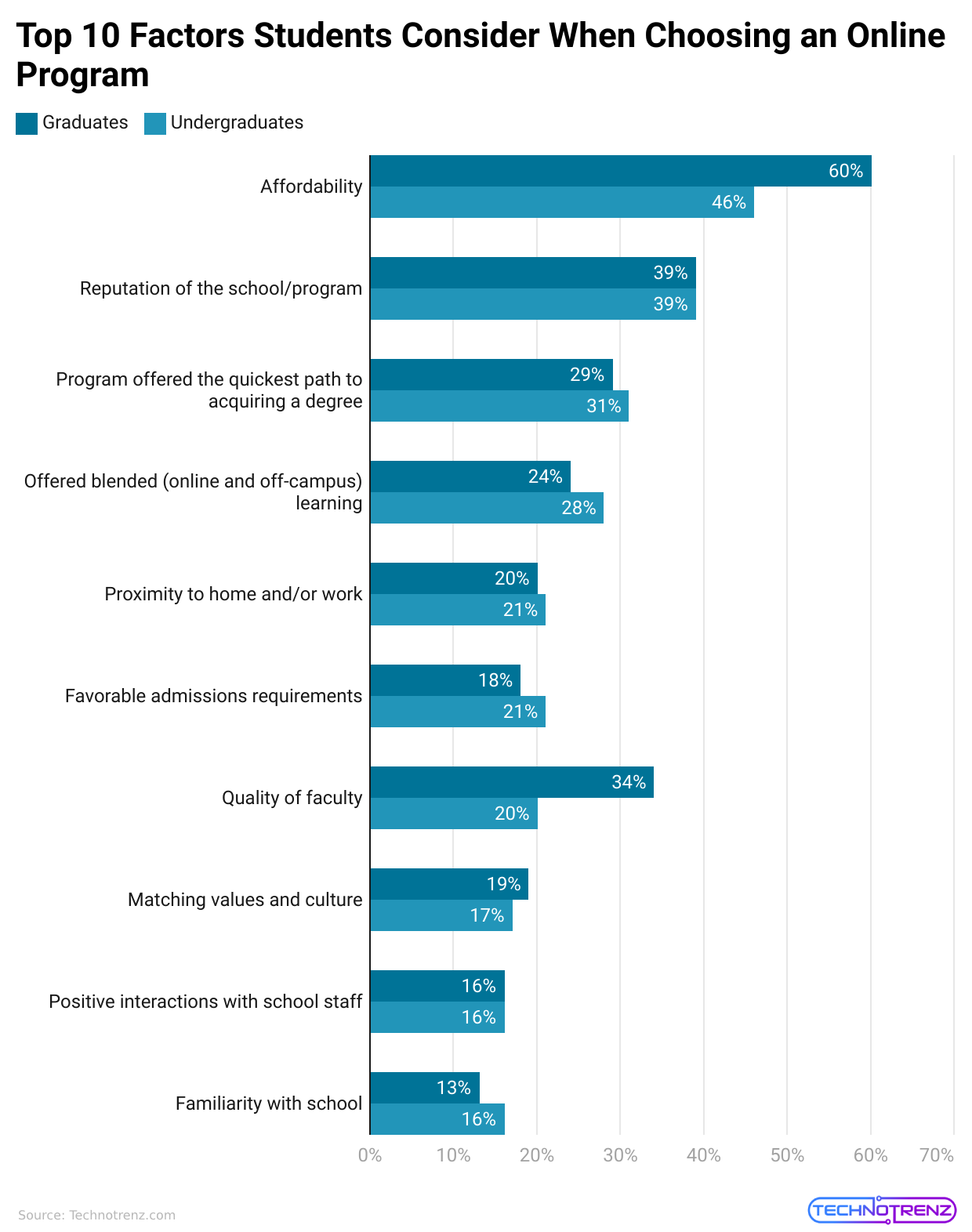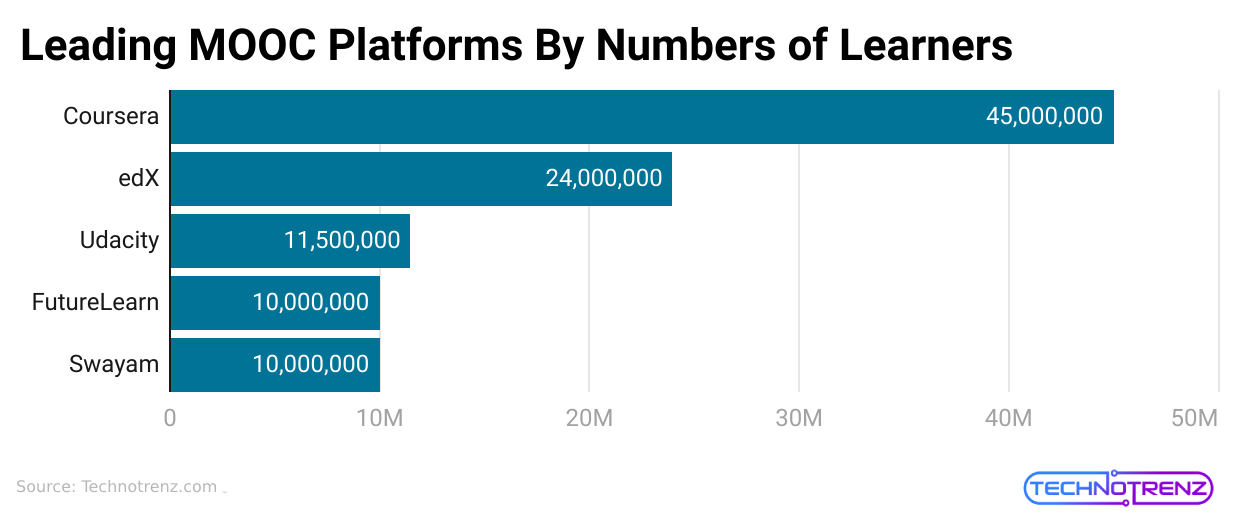Distance Learning Statistics 2024
Updated · Jul 24, 2024

WHAT WE HAVE ON THIS PAGE
- Introduction
- Editor’s Choice
- In Detail Online Learning Statistics
- Distance Learning Trends and Statistics
- Educational Statistics on Online Learning Platforms
- Online Courses and MOOC Statistics
- Corporate Online Education Statistics
- Global Online Learning Industry Facts & Statistics
- COVID-19 and Distance Learning Statistics
- Online Learning Statistics for Course Creators
- Conclusion
Introduction
Distance Learning Statistics: Technology advancements have led the educational sector into an era of digitalization. Distance learning or e-learning is an alternative method of learning that relies on flexibility. The following statistics on distance learning show that the implementation of a new educational model will yield more benefits and better results. Generations of today have an appreciation for computer-based learning which allows students to learn at their own pace and in a relaxing environment at an appropriate time. The market for E-learning is growing at an accelerated speed and expanding and positively impacting the environment and reducing time and cost. Since the COVID-19 virus has led to a shift towards remote work, people are increasingly relying on digital learning to build the ability to navigate the constantly changing workplace. The benefits of distance learning include more flexibility, greater autonomy, better time management, and also increased confidence in oneself.
Editor’s Choice
- As per the survey, distance learning can improve an employee’s performance by 15% to 25%.
- By 2026, the distance learning industry is estimated to be worth more than $370 billion.
- Online learning can decrease the time that is needed to learn a subject by 40% to 60%.
- Distance learning can grow students’ and employee’s retention rates to almost 50%.
- In 2021, with the investiture into scheduled learning the self-paced online market will decrease to $33.5 billion.
- Nearly, 63% of the students in the United States engage in distance learning activities daily.
- Almost 60% of online students state that their online education helped them improve their soft skills.
- Roughly 80% of the organizations now offer online learning or training solutions.
- By 2027, the number of users learning users is projected to increase to 57 million.
- Nearly 70% of the students state that online learning is better than the old traditional way of learning.
- The worldwide market experiencing almost 30% annual market growth includes Thailand, India, China, and the Philippines.
- About 63% of the students online commit to an online program as the reason that it is aligned with their present life/work responsibilities.
- Distance learning is the fastest-growing market in the educational industry and it has grown almost 900% after its creation in 2000.
- Globally, 49% of the students have completed some or the other sort of online learning.
- More than 6,900,000 students in the United States take at least one of their courses online.
- Nearly 34% of online students said that online studying is more preferred way of learning.
- In 2020, the mobile distance learning had grown by $38 billion.
- Microlearning has accounted for 60.7% of learning.
In Detail Online Learning Statistics
- As per Brandon Hall’s Study, online learning needs 40% to 60% less time than the old traditional learning method.
- By 2026, the worldwide distance learning Market to reach $457.8 billion.
- According to distance learning statistics, almost 62% of the students taking distance learning courses are females.
- The distance learning market has grown 900% globally since 2000.
- As per Business Wire, the corporate e-learning industry is projected to reach nearly $50 billion by 2026.
- As per Prosperityforamerica, by 2027 the online learning platform users are predicted to reach $57 million.
- Almost 70% of the students agree that online classes are better than traditional classes.
- American Heart Association states that e-learning improves employee performance by 15% to 25%.
- By 2020, 98% of United States corporations have incorporated online learning into their companies.
- The e-learning has helped the students to increase income from 42% of the US companies.
- Almost 50% of every 5 Fortune 500 companies take advantage of distance learning.
- Distance learning makes use of 90% less energy and 85% fewer CO2 emissions ever students.
- In 2020, almost 98% of the universities moved its class online.
- Distance learning can help students retain between 25% & 60% more information.
- As per bestcolleges.com, 95% of the e-learning students said they would recommend online education to others.
Distance Learning Trends and Statistics
- Distance Learning statistics state that 17% of females are more likely to enroll in e-learning.
- The corporate online learning market is predicted to reach $50 billion with a steady growth of 15%.
- An average employee has 24 minutes in a week to spend on learning therefore creating a challenge for developing careers.
- Almost 12% who did not complete their studies using the distance learning method would have if offered the chance.
- Nearly 67% of the colleges in the United States have completed their courses through their mobile phones.
- Roughly, 63% of the students In the US use online learning tools daily.
- The European markets and the United States combine almost 70% of the largest users of the e-learning services market worldwide.
- About 75% from the three-quarters of the United States learning institutions depend on the platforms.
- Every year other platforms include Academy of Mind, Ruzuku, and Skillshare with their tutors earning almost $40,000.
- The teachers and another platform have almost 7500 experts and they also give more than 20,000 courses online. In this case, they have about 3 million students.
- Udemy is the most popular distance learning platform and it has almost 20,000 experts with 12 million students taking a course.
Educational Statistics on Online Learning Platforms
- As per distance learning statistics, the Master Class has given up almost 515k+ free yearly memberships to underserved communities.
- Udemy has more than 69 million learners.
- As per TechCrunch, a quarter of the Master Class students say that taking Master Class classes has changed their lives.
- As per Coursera, courses that are four weeks long have a high completion rate.
- As per Mindvalley, 49.84% of their audience are males and 50.16% are females and a large number of visitors are between the age group of 25 years to 34 years.
- Lewis Hamilton has distributed almost 200,000 free yearly memberships and has become the first community ambassador working with Master Class.
- As per The Hollywood Reporter, The MasterClass celebrity instructors are paid almost $100,000 and also get 30% of the revenue of the classes.
- The trained tutors at Skillshare earn almost $3k every month on average.
- As per Udacity, in 2021 Udacity and AWS partnered together to offer 425 scholarships for the AWS Machine Learning Program.

(Reference: research.com)
- As per distance learning statistics, 81% of the Coursena students gave their courses a 5-star rating.
- The most popular MasterClass, Chris Voss Teaches the Art of Negotiation had almost 22,00,000 views and close to 2,000 likes.
- With almost 50 million students, Udemy is the most famous e-learning platform.
- In 2021, the online learning platform Coursera had recorded almost 20 million new registrations.
Online Courses and MOOC Statistics
- As per the survey Massive Open Online Learning Courses are currently being offered in most learning institutions.

(Reference: research.com)
- The maximum number of online courses in the United States are physically located in the US totaling almost 90%.
- The completion rate of the Massive Open Online Course in the United Kingdom is less than 13%.
- Nearly, 87% of students use a smartphone to search for an online course.
- The distance learning courses cut on cost with a credit hour ranging from $12 to $66 every credit hour.
- The students between the ages 5 to 17 contribute 3.1% that take an online school-related course.
- Nearly 79% of MOOC users already have a degree whereas 44% have a post-graduation degree.
- The Asia-Pacific region will emerge as the fastest-increasing market in MOOCs from 2020 to 2025.
- Among the top 25 universities in the United States, 22 of them offer distance learning courses.
- North America contributes to 29.4% of the global MOOC Market.
- EdX that is created by MIT and Harvard is the best example of MOOC and has almost 20 million users and about 70 million enrolments.
- The MOOC is estimated to have a market share of $21.4 billion by 2025.
- Almost 73% of the students are still unaware of MOOCs.
- From 2020 to 2025, the MOOC expects almost 29% of growth yearly in the market.
Corporate Online Education Statistics
- The advantages of microlearning are an improvement of 17% in learning transfer, a 50% improvement in engagement, a 300% increase in development speed, and a 50% reduction in development costs.
- The retention rate from microlearning is 70% to 90% and traditional is 15%.
- The average number of microlessons per microlearning course is 4-5.
- The microlearning uses bite-sized lessons that take just 5 minutes to complete in 2020.
- As compared to traditional learning, corporate distance learning takes 40% to 60% less time to develop.
- Almost 57% of the learning and development employees spend more time with online education than they do in their academics.
- About 41.7% of the Fortune 500 companies use technology for training professionals.
- Almost 62% of organizations use distance learning and development programs to close gaps in team members’ knowledge.
- The microlesson completion time is 5 to 7 minutes.
- The corporate learning sector may increase to $38.09 billion by 2024.
- The corporate e-learning sector is estimated to be worth $50 billion.
Global Online Learning Industry Facts & Statistics
- As per the European University Association, the crucial mission of the European Higher Education Area is to utilize digital learning to improve traditional higher education rather than replacing the latter with the former.
- As Germany’s economy grows at 1.9%, its distance learning market is growing at 8.5% per year.
- The distance learning market in the European Union is led by Germany.
- Nearly 52% of the students who graduated in the United States have an opinion that online college-level education provides a better learning experience than the traditional one.
- Currently, the MOOC market is valued at $5.16 billion and is estimated to grow at a 32.09% annual rate.
- 40% of the most popular MOOCs are easy to monetize like technology.
- Almost 99% of the students in the United States opt for online degree programs that are physically located in the country.
- The key trends of augmented and virtual reality will drive the distance learning sector in the future.
- The K-12 online learning market is growing in China by 20%.
- By 2024, the distance learning market is expected to reach$14.33 a billion in India.
- The biggest section of the global e-learning market is located in the US and Europe.
- As per distance learning statistics, about 30% of American students have enrolled themselves in at least one online course.
- Nearly 59% of the US distance learning market share comes from the content that is related to the products.
- The countries investing more than 50% are India, China, South Korea, the United Kingdom, Côte d’Ivoire, and the United States.
- Between 2017 and 2022, the distance learning market in the US will grow to $6.22 US billion.
- The global online learning market is predicted to reach $336.98 billion by 2026 with a CAGR of 9.1%.
- By 2025, the MOOC market will be worth $25.33 billion.
- Almost 39% of American undergraduate students consider online college-level education to be superior to classroom learning.
- Mostly 48% of K -12 students worldwide have online classes available to them.
COVID-19 and Distance Learning Statistics
- In 2020, almost 5% and more e-learning users are using online learning material than competing online courses.
- As per Statista, the secondary school saw a rise from 74% to 88% within a month between December 2020 and January 2021.
- By the end of 2020, almost 50% of parents in the US stated that their kid’s learning situations had changed to being remote full-time.
- According to distance learning statistics, 59% of low-income parents said that their children have issues in completing schoolwork remotely.
- As per the demographic differences among remote learner, 39% of the low-income households in the US canceled their classes.
- As per NPR, almost 16% of the Hispanic students and 15% of the black students in the US had no live access to teachers in 2020.
- In 2021, almost 94% of the secondary schools and 82% of the primary schools in the UK planned to provide.
- As per CNBC, 12 US statistics in 2021 found that passing rates in math and English language arts declined by 14.2%.
Online Learning Statistics for Course Creators
- Market research shows that creating an online course can cost anywhere from $140 to $10,770. This cost varies based on things like how it looks, how many sections it has, and if it offers a certificate.
- On average, creating an online course costs about $177. That’s not too expensive considering the potential for making money from it.
- Many successful course creators plan to sell memberships and offer coaching to students. This helps them build a community of people with similar interests.
- Compared to in-person training, creating and running an online course uses 90% less energy and produces 85% fewer CO2 emissions per person. It’s better for the environment!
- Successful course creators are twice as likely to use online communities to engage with their students. This makes the learning experience more interesting and interactive.
- Most top course creators sell more than one product or service, giving students different options to choose from and creating multiple sources of income.
- They’re also more likely to bundle their courses together for sale, which means offering related courses as a package deal.
- Many course creators use social media to attract students to their courses. Platforms like Facebook and Instagram are still popular places to find potential students.
- They also pay attention to how engaged their students are. Successful creators are twice as likely to track student activity and collect reviews and feedback. This helps them improve their courses.
- Offering free courses is a common tactic used by top creators to attract new students. It gives people a chance to see what the course is like before they decide to buy.
- Successful course creators often offer subscription pricing and upsell additional content to their students. This makes it easier for people to afford the courses and gives them more options for learning.
- Many of them use multiple sales tactics to attract as many students as possible. This might include things like discounts, promotions, or special offers.
- Finally, courses in business and marketing tend to be more expensive, with an average price of $234. This shows that people are willing to invest in learning skills that can help them succeed in their careers.
- Overall, this research highlights the importance of creating engaging courses, offering multiple products or services, and using various sales tactics to attract students and generate income.
Conclusion
Before the COVID-19 pandemic, the students globally had the same traditional schooling system, but from 2020 millions of schools and colleges were impacted making room for the distance learning system to grow faster. The expansion of distance learning has offered learners to be flexible and have easy access and education at a lower cost. On the other hand, learners and teachers alike are also seen to find classroom learning more manageable than distance learning. We have shed enough light on Distance learning statistics in the article above. These statistics make us think back to our own experiences in learning and sitting in a classroom without teachers.
Sources

Barry loves technology and enjoys researching different tech topics in detail. He collects important statistics and facts to help others. Barry is especially interested in understanding software and writing content that shows its benefits. In his free time, he likes to try out new healthy recipes, practice yoga, meditate, or take nature walks with his child.



